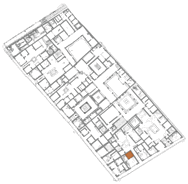Room 4
Description
Susanna Blåndman
This room is located in the northeast corner of V 1,2 It is square-shaped and measures approximately 8.4 m2. Room 4 is clearly defined by partition walls to room 3 and 5 and is entered by a 1.42 m wide doorway from room 3. The room contains a walled-up window in the north wall and an open window in the south wall. In the north wall beam holes in the upper part show that the room had an upper floor. Remains of eruption debris in the beam holes in the north wall indicate the collapse of the ceiling, and thereby the roof, during the eruption. There are also beam holes in the south wall, they are however located in a reconstructed part of the wall and are not authentic.
A doorway is located in the upper part of the west wall. None of the walls are standing to full height and they are all reconstructed in various parts. Remains of a lime-concrete floor were found in a large part of the room, primarily in the north half. Scant remains of a cocciopesto floor were found above this floor. Remains of a structure from an earlier building phase were found in the southwest corner of the room.
Relationship between the studied walls and floor surfaces in room 4
The south wall abuts on the east wall and there is a narrow space between the walls in the lower part of the corner. The east wall continues into room 3. The north wall is to some part built at the same time as the east wall. The corner of the walls reveals that they were built as a single unit up to where the opus testaceum ends, at the height of 2.80 m. From that height and upwards the opus incertum of the east wall abuts on the north wall. The remains of the cocciopesto floor abut on the north wall meaning that it was laid after the wall was built. The west wall abuts on the north wall. The west wall is built at the same time as the south wall. The corner of the walls is built as a coherent unit. This corner is reconstructed from approximately the height of 2.00 m and upwards. The lime-concrete floor continues partly under the west wall meaning that the west wall is built after the lime-concrete floor was laid.

